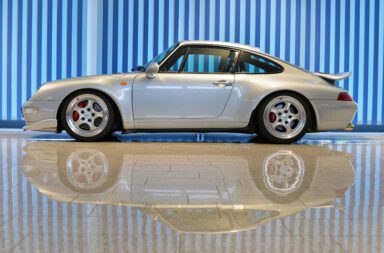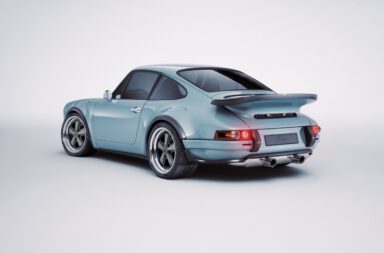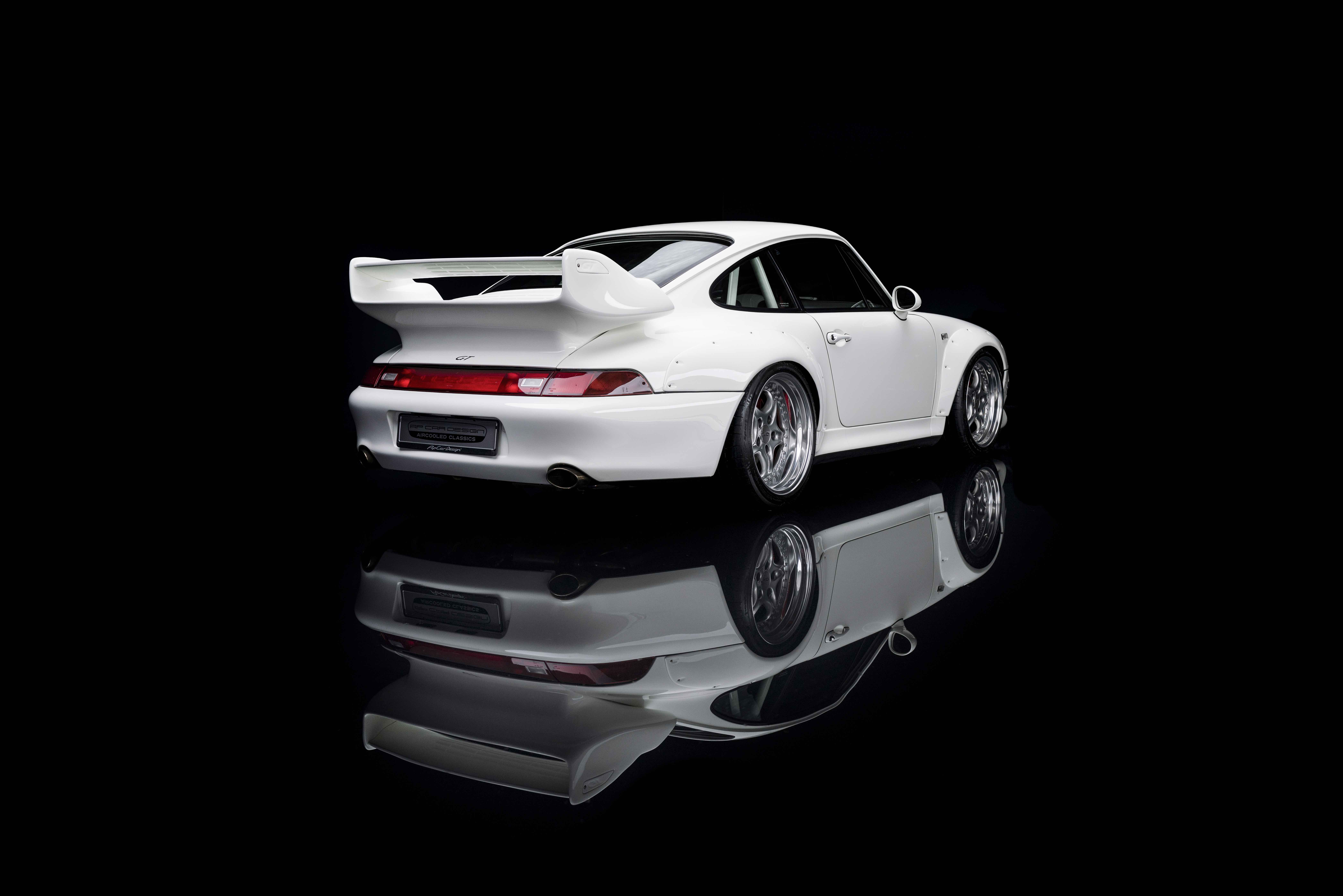The 917 Coupé in the “psychedelic” look of Porsche chief designer Anatole Lapine is the result of daring tricks up to two documented chassis changes.
A “hippie” on wheels: During his lifetime, Porsche design chief Lapine gives the 917 long-tail coupe with chassis end number 043 the “psychedelic” look.
Hardly any other racing prototype from Porsche is surrounded by as many legends, myths and legends as the 917 rear-end coupe with the chassis end number 043. After finishing second in the Le Mans 24 Hours in 1970, this chassis fell victim to an accident in the fall of the same year during test drives at the Hockenheimring. The number 917,043 goes on in the following 917,044. In 1971, she shined under Jackie Oliver in pre-training for the 24 Hours of Le Mans with a new, unbelievable run-record. The Briton in Porsche services sets 3.13.6 minutes ago. On the long straight, the future owner of the Arrows team in Formula 1 reaches 386 km / h. The lifeline of the world-famous “Hippie” Porsche – that flounder in the twisted arabesque gown of dark blue and bright green, separated by white lines – remains interrupted despite everything. The Latvian Anatole “Tony” Lapine, head of the Porsche design studio since 1969, designs the “psychedelic” painting in the laboratory at home – and uses spray cans at the classic Porsche base, a small village workshop in Teloché. In Thursday’s training, the bright green sections in white are primed – evidence of an experimental age. The anecdote about re-spraying the recessed color spaces in the open air has since become one of the Highlights of the company history. It underscores joke, a shaken measure of charm – and success. Not only does the 917,043, which has been transformed into a monument in an adventurous way, take second place. The Willibald Kauhsen from Aachen and his French racing team colleague Gérard Larousse take over the wheel during the 24 Hours of Le Mans in 1970. At the top, the duo is the first of 16 Porsche triumphs on the Sarthe. Hans Herrmann will have the honor of piloting another icon of the era, the red-and-white “Kartoffelkäfer” (a 917 short-tail coupe with chassis end number 023), together with Richard “Dick” Attwood. Twelve months earlier, Hans Herrmann missed this success by a hair’s breadth. In the Porsche 908 Coupé he delivers himself with the Belgian Jacky Ickx on Ford GT40 a duel on the knife edge. At the finish – after 24 hours of racing – the distance between the opponents is less than 100 meters. To the detriment of the Germans.
The Visual Realization of Consciousness Augmentation: Lapine’s legendary “hippie” design leaves a genre picture of the untamed seventies
Bright colours, restless ornaments, and again and again arabesques – for the intellectuals, the dawn of the seventies is a noise-like condition. Metropolises are full of substances that promise to expand awareness. Since they are almost without exception illegal, they show them a wickedness that their consumers take as a strong irritant privilege. A new, untamed age has begun. With all its facets and effects on the social life, it immediately takes on art. Around the world, creatives try to pinpoint the emotional world of the “hippie” generation with their work. Intertwined patterns, together with glaring, wildly interconnected colors and writings, are meant to express what people carry in their heads and hearts. In this way, he created free-spirited moral scenes, which Porsche transferred in June 1970 to one of the house’s most prominent Le Mans prototypes, the 917 long-tail coupe. Conte Gregorio Rossi di Montelera first has to give his consent. The aristocratic maker of the Martini Racing Team agrees on the condition that the logos of his Vermouth brand be included, at least in a reduced form. This plan succeeds, to the delight of Hans-Dieter Dechent. The German is in front of the Martini racing team, under whose flag Gérard Larrousse and Willi Kauhsen compete for the 24 Hours of Le Mans. Compared to the more compact “Colorado Beetle” by Hans Herrmann and Richard “Dick” Attwood, the “hippies” are clearly faster, but also more dependent on the weather. When it rains, the long tail version is harder to control. And it’s pouring 16 out of 24 for 24 hours – the race is decided early. After Kauhsen / Larrousse have reached the second overall position at the finish, their test rides must continue. Unfortunately, they lead to the near total loss of the Chassis 917,043. Hans-Dieter Dechent, the team manager of the Martini Racing Team, wants to continue the “hippie design”. However, this can only be achieved with a rented short-tail customer’s car, which eventually represents the niche Volkswagen importer Antti Aarino Wihuri. He himself has undergone a change of chassis after the crash of the 24 Hours of Le Mans. It is doing what is common in that epoch of motorsport: components that are still intact, along with spare parts, are taken over into a replacement frame that receives the existing chassis number. The consequence: At the Nuremberg Norisring starts the chassis number 917.021, which actually does not exist, as a motley collection of various parts. In the Porsche nomenclature, it remains with the originally issued to Antti Aarino Wihuris AAW racing team frame number, and this circumstance will be in the further course of this story of the utmost importance.
Profits, Losses: A wild period of time dissolves in a discarded rolling chassis – from a South African backyard to the Südliche Uferstraße
Antti Aarino Wihuri. The rain crash at the Le Mans 24 Hours – also in third place – is truly not the only low blow for him. Two weeks earlier, he lost a young, up-and-coming driver and compatriot at the Nürburgring Nordschleife, Hans Laine, in the Porsche 908/02 of the AAW team. He is levered out and turned upside down due to an air cushion under the front car. Since it is an open, two-seat racing prototype, it remains on the roll bar. It comes to disaster – fire breaks out, and the hurrying driver colleagues must sit idly by Laines terrible fate. The team, which includes the Danish rally authority Pauli Toivonen, retires. At the Sarthe, the Dutchman Gijs van Len- nep and the rent-paying Englishman David Piper are called. The guest driver, who is still active in historic motor sports, has a 917 coupe himself, but he does not want to expect the murderous material test twice around the clock. After the season highlight, he wants to switch back to his own car. The islander, however, injured in the Shooting of the film “Le Mans” by and with Steve McQueen on the lower leg, which he loses due to a gangrene. Gijs van Lennep, on the other hand, will receive Antti Aarino Wihuri. On July 5, 1970, the Dutchman will be honored to present a well-known color scheme at Interser Hockenheimring: It is the “hippie” design that now, at the behest of the Martini Racing Team, is the coupé body of the leased AAW -Orsche graces. On August 23, 1970, the Scandinavians, now back on their own and their sponsor Shell, draw the next wild card: Before their home game, the Interserie run in the niche of Keimola, they replace the blue lilac by shell yellow, and the bright green color components Shell red. Only the contours keep it – and immediately establish another legend. At the Nine Hours of Kyalami 1970 in far-away South Africa, the career of the Porsche 917.021 expires – fortunately only for the time being, as Manfred Freisinger gets hold of it. The Karlsruhe used parts dealer buys the orphaned rolling chassis, but without the drive unit. The reason: Wihuri is switching to an open 917/10 Spyder and has the most important components transferred to its new chassis. What remains of the action, buys the German Joachim Grossmann. It is reported that he transformed 917,021 from 1975 to 1977 into a road vehicle and finally, too. From there, it continues through various private collections before a Colombian residing in Denmark enters the patricianship of the owner and conqueror of a 917 Coupé in 2004. His name: Juan Barazi. After discovering the CER race format (Classic Endurance Racing in the long version, ed.) As the preferred playground, in the summer of 2004 he challenged David Piper at the Nürburgring to fight among 917 owners. The duel causes a sensation, and so behind the scenes, the next and last change of holders is emerging: The Belgian Vincent Gaye embarks on the adventure, and in fact: It’s going to be exciting!
Robert Lünsmann’s framework teaching and the consequences: The second change of chassis in the life of 917.021 is due to age – it crunches suspiciously in the entablature
Cracks are not uncommon in 40-year-old aluminum pipes. Especially not when this highest dynamic
Loads are exposed. The Belgian brothers Kupka, who are responsible for the technical support of the Porsche 917.021 in their company MEC-auto, know that too take over. After they have completely dismantled the new addition to their workshop operation, they get in touch with the Duisburg materials tester Robert Lünsmann. Even a formerly active racer in the Renault-Markenpokalen, brings Lünsmann with the necessary know-how. To the annoyance of all participants, he identifies irreparable damage, all of which is age-related. Particularly affected are the crossing points on the underside of the chassis, which suggest a new frame construction. Safety aspects are in such considerations in the foreground, especially since Vincent Gaye wants to participate actively in the historic motorsport. So he has decided to attend the biennial Le Mans Classic. He commissions comprehensive recreation, including new bodywork trim parts. At the same time, an international consortium of eyewitnesses, historians, photographers, authors and other professionals starts its work. Everywhere in the world research is done to create an accompanying documentation book. It traces the history of the Porsche 917.021, from whose original details not many are installed. Since then, Vincent Gaye and the retreaded “Hippie” coupé have been welcome guests at major historical events such as the CER series in Spa-Francorchamps, Belgium or the “Classic Day” at Porsche Center Aachen. All’s well that ends well? Anyway – from the United States it can be heard that a second short-tail coupe claims to be the Porsche 917.021. Internationally respected restaurateur Kevin Jeannette completed the project and demonstrated at the Monterey Historic Races in Laguna Seca two years ago. The color scheme is based on the 24 Hours of Le Mans in 1970 – yellow and red, combined with “Sandemann” stickers on a white background. Originally, David Piper brought in this personal sponsor to fund his guest assignment. As so often in the case of vehicles of museum stature, an arbitrator’s vote in favor of one or the other version is almost impossible. The quality of his contenders – all people of distinction and rank – speaks for the European version, which Vincent Gaye and his network have achieved. In the book “The Fabulous Story”, which is dedicated exclusively to the Belgian 917.021 and sets completely new quality standards, all the protagonists have their say. Above all, the man who coordinated the Porsche customer sport for decades and sat at the wheel of a winning car at the Le Mans 24 Hours in 1977: Jürgen Barth. His assessment is law in the commissions of Europe, which have to be above the rolling celebrities. Of course he has also made a placet to the “hippie” from Verviers, which lies in the Belgian Ardennes. Therefore, it is definitely worth reading the (translated) “fabulous story” of the last existing Porsche of the “psychedelic” prototype era!
research and words by Carsten Krome Netzwerkeins


